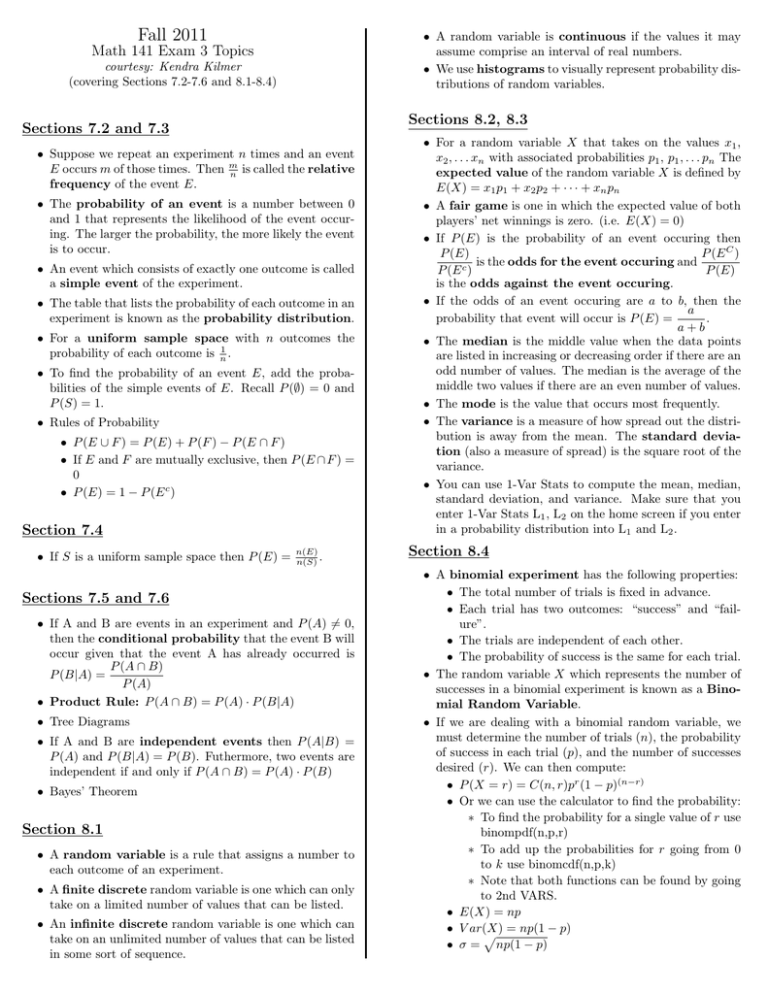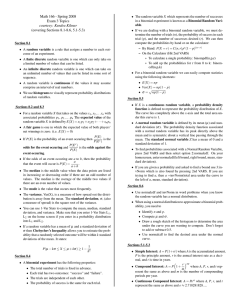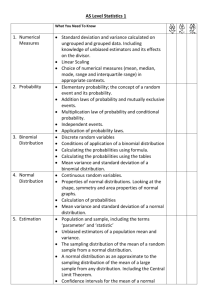Fall 2011 Math 141 Exam 3 Topics
advertisement

Fall 2011 • A random variable is continuous if the values it may assume comprise an interval of real numbers. • We use histograms to visually represent probability distributions of random variables. Math 141 Exam 3 Topics courtesy: Kendra Kilmer (covering Sections 7.2-7.6 and 8.1-8.4) Sections 8.2, 8.3 Sections 7.2 and 7.3 • Suppose we repeat an experiment n times and an event E occurs m of those times. Then m n is called the relative frequency of the event E. • The probability of an event is a number between 0 and 1 that represents the likelihood of the event occuring. The larger the probability, the more likely the event is to occur. • An event which consists of exactly one outcome is called a simple event of the experiment. • The table that lists the probability of each outcome in an experiment is known as the probability distribution. • For a uniform sample space with n outcomes the probability of each outcome is n1 . • To find the probability of an event E, add the probabilities of the simple events of E. Recall P (∅) = 0 and P (S) = 1. • Rules of Probability • P (E ∪ F ) = P (E) + P (F ) − P (E ∩ F ) • If E and F are mutually exclusive, then P (E ∩ F ) = 0 • P (E) = 1 − P (E c ) Section 7.4 • If S is a uniform sample space then P (E) = n(E) n(S) . Sections 7.5 and 7.6 • If A and B are events in an experiment and P (A) 6= 0, then the conditional probability that the event B will occur given that the event A has already occurred is P (A ∩ B) P (B|A) = P (A) • Product Rule: P (A ∩ B) = P (A) · P (B|A) • Tree Diagrams • If A and B are independent events then P (A|B) = P (A) and P (B|A) = P (B). Futhermore, two events are independent if and only if P (A ∩ B) = P (A) · P (B) • Bayes’ Theorem Section 8.1 • A random variable is a rule that assigns a number to each outcome of an experiment. • A finite discrete random variable is one which can only take on a limited number of values that can be listed. • An infinite discrete random variable is one which can take on an unlimited number of values that can be listed in some sort of sequence. • For a random variable X that takes on the values x1 , x2 , . . . xn with associated probabilities p1 , p1 , . . . pn The expected value of the random variable X is defined by E(X) = x1 p1 + x2 p2 + · · · + xn pn • A fair game is one in which the expected value of both players’ net winnings is zero. (i.e. E(X) = 0) • If P (E) is the probability of an event occuring then P (E C ) P (E) is the odds for the event occuring and c P (E ) P (E) is the odds against the event occuring. • If the odds of an event occuring are a to b, then the a probability that event will occur is P (E) = . a+b • The median is the middle value when the data points are listed in increasing or decreasing order if there are an odd number of values. The median is the average of the middle two values if there are an even number of values. • The mode is the value that occurs most frequently. • The variance is a measure of how spread out the distribution is away from the mean. The standard deviation (also a measure of spread) is the square root of the variance. • You can use 1-Var Stats to compute the mean, median, standard deviation, and variance. Make sure that you enter 1-Var Stats L1 , L2 on the home screen if you enter in a probability distribution into L1 and L2 . Section 8.4 • A binomial experiment has the following properties: • The total number of trials is fixed in advance. • Each trial has two outcomes: “success” and “failure”. • The trials are independent of each other. • The probability of success is the same for each trial. • The random variable X which represents the number of successes in a binomial experiment is known as a Binomial Random Variable. • If we are dealing with a binomial random variable, we must determine the number of trials (n), the probability of success in each trial (p), and the number of successes desired (r). We can then compute: • P (X = r) = C(n, r)pr (1 − p)(n−r) • Or we can use the calculator to find the probability: ∗ To find the probability for a single value of r use binompdf(n,p,r) ∗ To add up the probabilities for r going from 0 to k use binomcdf(n,p,k) ∗ Note that both functions can be found by going to 2nd VARS. • E(X) = np • V ar(X) p = np(1 − p) • σ = np(1 − p)










